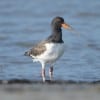 By Jim Stevenson
By Jim Stevenson
The Wednesday morning field trip (8:30 am till noon) is ON. October is a very birdy time, so catch the migration! $25 Parking Lot at the West End of the Seawall. We’ll also have a Sunday morning FT; same deal. Friday, we are having a terrific birding field trip to the east side of Galveston Bay. We will probably visit the hawk-watch tower, plus shorebird migrants and songbirds at High Island. Long, fun trip and lotsa birds. Hand-held cameras only. $100. Meet at the post office on Broadway near 61st Street at 7 am. Saturday, we will have a 6-hour birding field trip on West Galveston Island, 8-2 pm. Bring snacks. No tripods; cameras fine. $50 Meet at MY PLACE (in the cul-de-sac). We’ll do songbirds and shorebirds.
We have quite a few new people on the list and perhaps some of you that haven’t responded yet to our annual “calendar” sale. I am in the middle of sending them so please take a look!
The gallery is on many of the shorebirds seen at this time of year, including their “winter” plumage. It has the added curiosity of being written largely after midnight, so Lord only knows what I wrote! Winking smile.
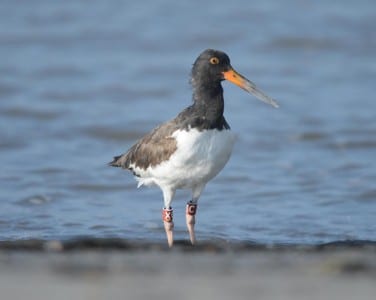
One of my many mini jobs as Director of the GOS is to report banded birds to the proper authorities. I’ll show you three different species in this PDF with various bands, with these being quite classy. Note the American Oystercatcher has been probing in the (nasty) mud, “looking” for bivalves. Photographers- the lower you get on birds on the ground, the better your image will appear. Like this bird, sometimes you can only get so low.
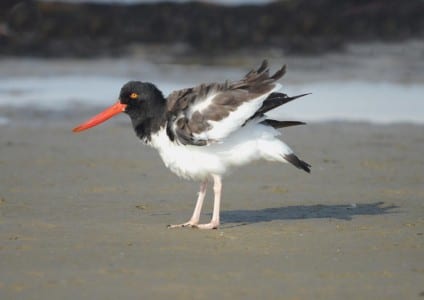
It’s amazing how a little clean-up in the Gulf will cause colors to stand out. I wonder if it looked like Senor BANDito an hour ago. Oystercatchers have very thick skin on their feet and a compressed bill to slip into the bivalve and snip the adductor muscle. I really like the color coordination between the eye and bill, but they shouldda gotten a gay guy who understands colors better than the poor soul who designed the flesh-colored legs.
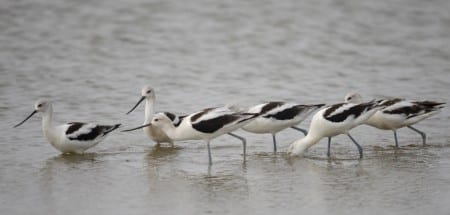
This flock of avocets has just returned from the Northwest and is enjoying a plankton buffet, p robably on their diet. Like most birds, they return in basic (winter) plumage, finally returning to alternate (breeding) plumage beginning in March. Kinda looks like they’re already marching… OK, p lease note the sexual differences in their bills. Females (left bird) have more upturned bill than males (the next two from the left). Let’s see how well you do: Which sex are the three on the right?
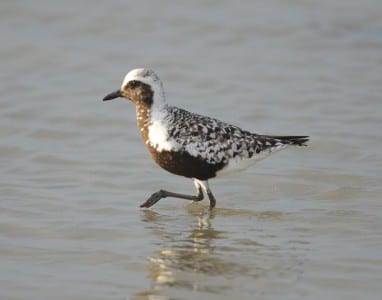
Note their large bill and black undersides to help incubate eggs with the sun low on the horizon, 24-hours/day. Many BBPLs migrate well down into South America, but not as far as Goldens.Black-bellied Plovers often return in close to full breeding plumage from their Arctic nesting grounds. The white bleeding is what happens when you shoot a picture at 11 in the morning.
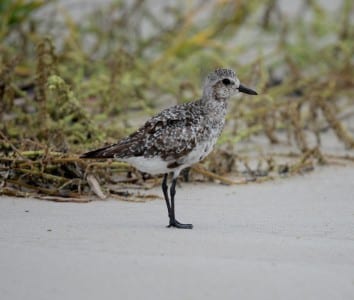
This nasty thing is a changing-plumaged BBPL, about 75% back to winter plumage (is actually 74.294%). Why lose the black? Those melanins must be manufactured, and that’s an unnecessary energy expense. Organisms survive by expending the least amount of energy possible. It’s a great excuse to be lazy.
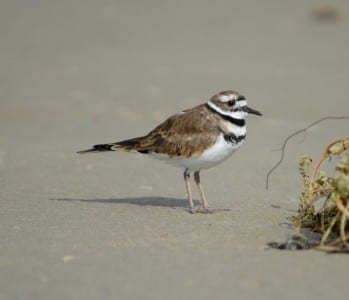
A rather odd plover is the Killdeer, without any close relatives on Earth. It’s really more upper terrestrial than beach dwelling, but migrants drop down in fall anywhere. The two rings do not denote polygamy, but Killdeer have been known to step out. This bird looks a little ratty and perhaps a molt is eminent.
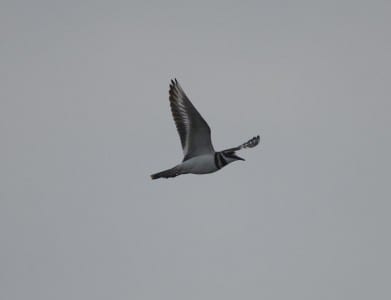
Fall migrant Killdeer come south and upon reaching the coast, turn east and follow the coastline until they get to the area where they winter. Other winter residents like Whitefronted Geese and kestrels do this as well. They will be in small flocks, and even throughout the winter, but in spring, a few pair off and raise their chicks right here!
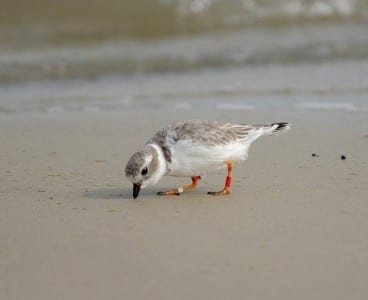
Large plovers like BB are in the big genus Pluvialis, but my favorites are the smaller ones, in Charadrius. And whoever said small plovers had bands knew what they were talking about (the bands…). This species loses their complete ring and dumbs it down to a half-ring for winter. Note how our hero is looking for food on the surface, true to its plover biology.
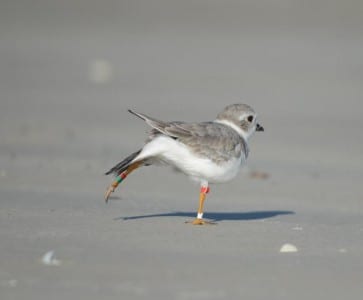
As you can see, the color bands are different on this bird, and using the colors, researchers can recognize the bird from their records. Most banded birds are endangered, threatened or species of special concern. Piping are in bad shape due to dogs and cats, beach traffic and destruction and untimely storms. They do not breed here like Wilson’s (and Snowies used to), but rather in places like the NE Coast.
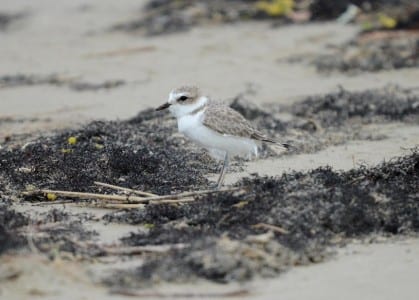
Snowy Plovers are similar but have a longer bill and longer, gray legs. These are doing fairly well, but back East the Cuban Snowy Plover is struggling badly, mostly due to building condos all along Florida’s Gold Coast, etc. Interestingly, they are whiter back East, no doubt coz the sand east of the Mississippi is much whiter. Sediments from the M river flow west coz of long-shore currents. That’s why the Texas and Louisiana Coasts are dingy. Test on this Tuesday.
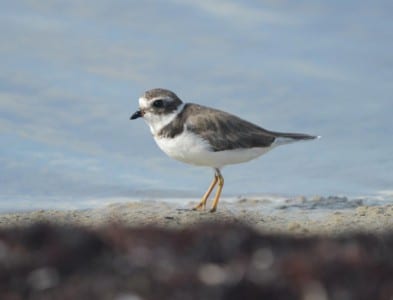
Unlike the last two species, Semipalmated Plovers have a dark back and a fairly complete ring even in winter. They have a much larger range than the other small plovers, even nesting in the Arctic. I remember one in Prudhoe Bay that simply wouldn’t give ground when I approached, basically staring me down. It did seem a little defeated, though, when I stomped her eggs and laughed.
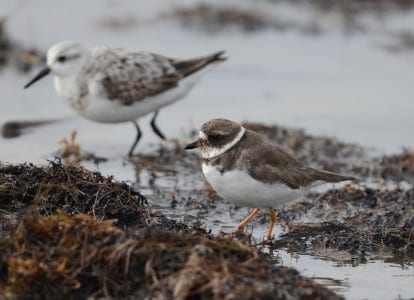
These four small plovers are about the size as the Sanderling (behind), but they always have a bit shorter bills than sandpipers. This bird is losing the last of the orange in the bill for the winter, but it always comes back. With the small bill and orange legs, they are really a dark Piping. However, they are much more catholic ecologically, more than nun other. (midnight) 😉
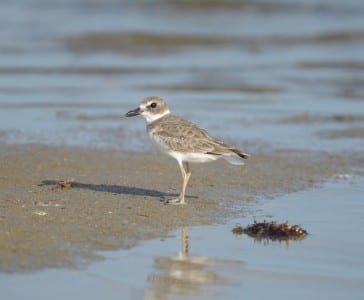
Just a bit larger than the other three, the Wilson’s Plover has flesh-colored legs for hiding in the nude sunbathers (OK, no more of that), and a large bill for crunching small crabs. These are summer residents in our Country, raising their chicks around salt marshes and other areas with fiddler crabs. A few will winter on the South’s Gulf Coast, not migrating south since winter temps have moderated.
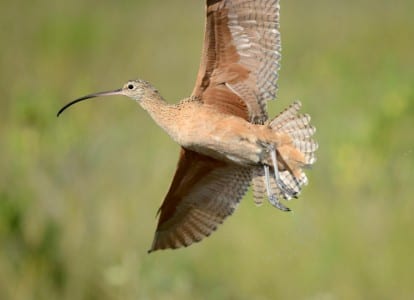
This is not a plover. 😉 Long-billed Curlews and Marbled Godwits nest in the short grass prairie out West and this species winters west of the Mississippi River. This female has a bill like a reel’s rod, and they are quite adept at sliding it down a fiddler crab’s burrow. Others enjoying the numerous crabs include Clapper Rail, Willet, Wilson’s Plover, Whimbrel, Yellowcrowned Night-Heron, and another one apparently removed from my memory by Sir Jerry did this last fall.
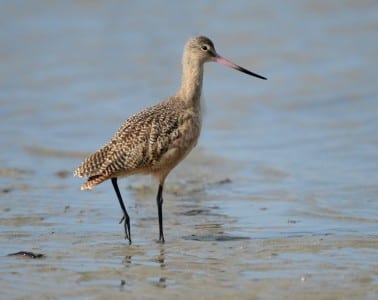
Built about like a curlew but very different in bill direction and feeding style is the Marbled Godwit. Do you remember why they have that black tip? Right! It stiffens the bill and allows them to hit stuff like shells when probing, without cracking their bill. Hey, would somebody PLEASE hit the contrast key!!!
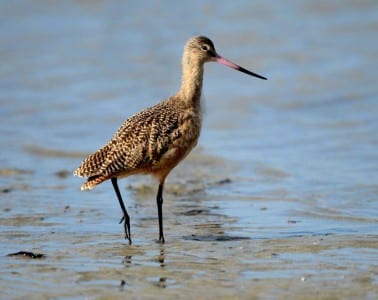
Thank a vu y gratse tu. You guys with Photoshop, etc., should use the contrast key to make plain birds pop out a bit. Just not so much that he looks like a Hudsonian! :0- Go back and forth and compare… The best way to learn Photoshop is to experiment with the various buttons, remembering that you don’t have to save it!
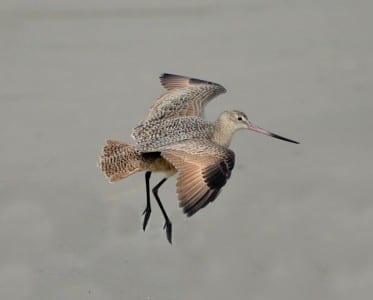
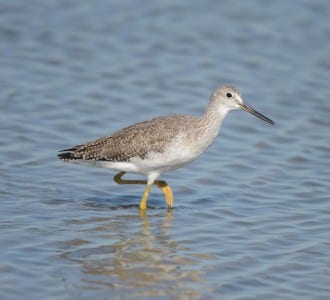
Greater Yellowlegs are winter residents that arrive in their winter coat like the above. Note the bill is almost twice as long as the head, and you can’t miss their loud, ringing calls. They generally do not flock, like Lessers in the migration, partly because they are continental migrants (winter residents) not wintering south of here, and are a bit territorial. They are never seen flying circum- or trans-Gulf.
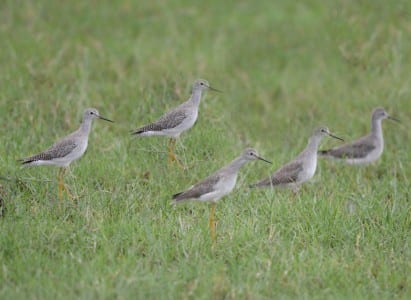
Here is a typical flock of Lesser Yellowlegs, except that very few flocks have individuals whose heads have been pasted on their companions. Hey, heads-up! These Killdeersized birds have a very long f light to the Tropics (mostly) and then can nest all the way into the Arctic spruce bogs. Many shorebirds have migrations of several thousand miles.
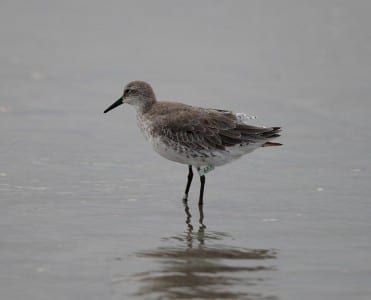
Note the winter-plumaged Red Knot, a species of special concern. That’s why it’s banded, so we can learn more abut their movements and protect them better. BTW, as you can see below, not all birds are exactly the same, and some like Herring Gulls look like they came from a different planet from others.
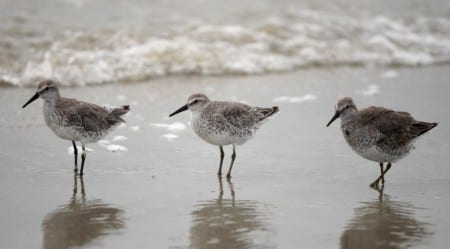
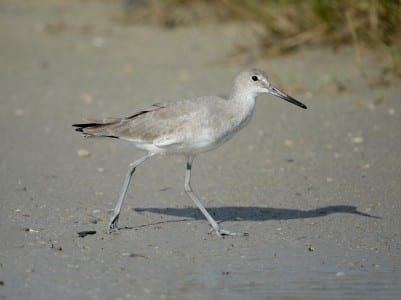
Here is the Western Willet, the only Willet we have after Labor Day. Note the long legs and bill, p lus the slender body. The noisy, fat, tub-‘o-lard we have in spring is resting comfortably in the Tropics right now. This population works the beach side mostly, catching arthropods like swimming crabs and coquina (and sometimes small fish!), while the breeding Willets in spring rely heavily on fiddler crabs.
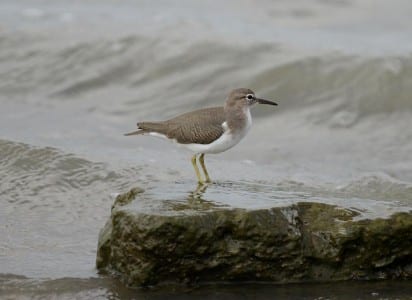
Look what I spotted! Yes, this is the Spotted Sandpiper, named for the dark spots below that disappear in August. However, the winter bird still has the bold eyering, and teeters up and down when nervous. This bird seems amazingly calm. 😉 Also, when Spotteds fly, they seem to fly with “stiff” wings, not downstroking like most birds. This species has the longest winter range, north to south, of any bird on Earth: New England to southern South America. I’ve even seen them on inland rivers in South America.
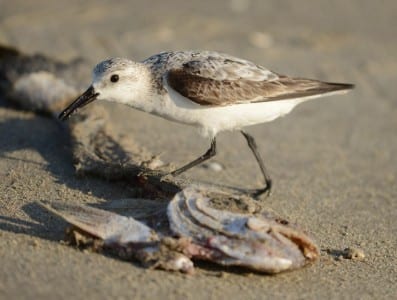
Sander lings are abundant winter residents, working the matching beaches for insects and other invertebrates often slightly below the surface. This one is snatching shore flies off a trout and showing the occasional boldness of the species. Little known factoid: My van is nicknamed “The Sanderling.” (white, runs on the beach, etc).
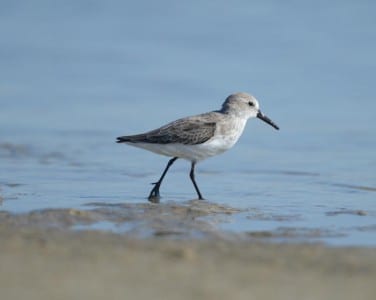
Western Sandpipers are our most abundant shorebirds, nesting by the trillions (well, ok, a bunch) in places like western Alaska. They are told from Semipalmateds, who don’t winter in the Continental US, by a longer bill with a teenincy 😉 droop on the end. OK, there’s more, like the Semi-pee (as my friend Doug calls them) has a thick base to the bill and has a bit of webbing on the toes. My mind is racing at this late hour with puns about that nickname.
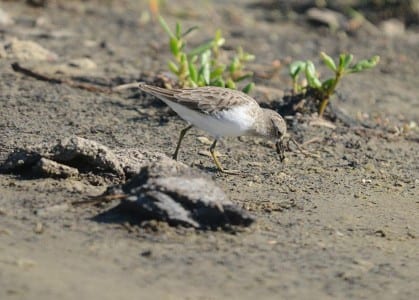
Least Sandpipers are browner – even in this winter plumage – because they tend to work farther from the water. Further? I forget. They may even be seen in ditches and tiny puddles, so long as there are small “bugs” to grab. These have shorter migrations, and therefore shorter, more rounded wings. Structure – function. At last, bedtime!

 Posted in
Posted in 























